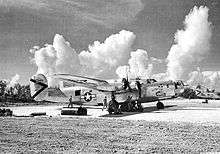864th Bombardment Squadron
| 864th Bombardment Squadron | |
|---|---|
|
Emblem of the 864th Bombardment Squadron | |
| Active | 1943–1966 |
| Country | United States |
| Branch | United States Air Force |
| Type | Bombardment |



The 864th Bombardment Squadron is an inactive United States Air Force unit. Its last assignment was with the 494th Bombardment Wing, based at Sheppard AFB, Texas. It was inactivated on 2 April 1966.
History
Established in late 1943 as a B-24 Liberator heavy bomb squadron under II Bomber Command at Wendover Field, Utah; later moving to Mountain Home Army Air Field, Idaho to complete its final phase of training. At Mountain Home, the squadron received new very long range B-24J aircraft in early May.
Deployed to Hawaii Territory and assigned to VII Bomber Command. Remained in Hawaii with aircraft undergoing modifications while training for long range flights over the Pacific Ocean. Deployed to Angaur in the Palau Islands in October, flying very long range combat missions against Japanese airfields on Yap and Koror. Conducted strikes on other bypassed enemy installations in the Pacific and against the Japanese in the Philippines. Late in 1944 hit gun emplacements, personnel areas, and storage depots on Corregidor and Caballo at the entrance to Manila Bay; bombed radio installations and power plants at Japanese bases in the Philippines; and attacked enemy-held airfields, including Clark Field on Luzon. Early in 1945 struck airfields on Mindanao and ammunition and supply dumps in the Davao Gulf and Illana Bay areas.
Moved to Okinawa in June 1945. Engaged primarily in attacks against enemy airfields on Kyūshū until V-J Day. Also participated in incendiary raids, dropped propaganda leaflets over urban areas of Kyūshū and struck airfields in China, in southern Korea, and around the Inland Sea of Japan.
After the war's end in September, the unit remained on Okinawa as older units began to demobilize. The squadron was engaged in transporting personnel and supplies in the Southwest Pacific, and moving necessary occupation support elements from Manila to Tokyo. Began to demobilize in November and December, with personnel returning to the United States; inactivated as a paper unit in the United States on January 4, 1946.
Reactivated by Strategic Air Command in 1958 as Missile Training squadron at Redstone Arsenal, Alabama. Provided training for Italian Air Force personnel in the operation and launching of the PGM-19 Jupiter Intermediate-Range Missie. Inactivated 1 June 1960.
Reactivated under Strategic Air Command in 1963, being a redesignation of the provisional 717th Bombardment Squadron, consisting of 15 B-52D Stratofortresses at Sheppard AFB, Texas. Performed intercontinental training and deployments, also standing nuclear alert. By 1966, Intercontinental ballistic missiles (ICBM) had been deployed and become operational as part of the United States' strategic triad, and the need for B-52s had been reduced. In addition, funds were also needed to cover the costs of combat operations in Indochina. The squadron was inactivated on 1 April 1966 and its aircraft were reassigned to other SAC units.
Lineage
- Constituted 864th Bombardment Squadron (Heavy) on 14 September 1943
- Activated on 1 December 1943
- Inactivated on 6 January 1946
- Redesignated as: 864th Strategic Missile Squadron (IRBM-Jupiter) on 7 January 1958
- Activated on 15 January 1958
- Redesignated as: 864th Technical Training Squadron on 15 April 1959
- Discontinued on 1 June 1960
- Redesignated as: 864th Bombardment Squadron (Heavy) on 15 November 1962
- Organized on 1 February 1963; receiving personnel/aircraft/equipment from 717th Bombardment Squadron (Inactivated)
- Inactivated on 2 April 1966.
Assignments
- 494th Bombardment Group, 1 December 1943 – 4 January 1946
- 1st Missile Division, 15 January 1958
- 704th Strategic Missile Wing, 23 February 1958
- Attached to 1st Missile Division, 1 November 1958
- 1st Missile Division, 1 July 1959
- Department of the Air Force, 1 June 1960
- Strategic Air Command, 15 November 1962
- 494th Bombardment Wing, 1 February 1963 – 2 April 1966
Stations
- Wendover Field, Utah, 1 December 1943 – 15 April 1944
- Mountain Home Army Air Field, Idaho, 14 April 1944 – 15 June 1944
- Barking Sands Army Airfield, Hawaii Territory, 15 June 1944 – 30 September 1944
- Angaur Airstrip, Angaur, Palau Islands, 30 September 1944 – 24 June 1945
- Yontan Airfield, Okinawa, 24 June 1945 – 13 December 1945
- Redstone Arsenal. Huntsville, Alabama, 15 January 1958 – 1 June 1960
- Sheppard AFB, Texas, 1 February 1963 – 1 April 1966
Aircraft
- B-24 Liberator, 1944–1945
- B-52 Stratofortress, 1963–1966
See also
References
![]() This article incorporates public domain material from the Air Force Historical Research Agency website http://www.afhra.af.mil/.
This article incorporates public domain material from the Air Force Historical Research Agency website http://www.afhra.af.mil/.
- Maurer, Maurer, ed. (1982) [1969]. Combat Squadrons of the Air Force, World War II (PDF) (reprint ed.). Washington, DC: Office of Air Force History. ISBN 0-405-12194-6. LCCN 70605402. OCLC 72556.


.svg.png)